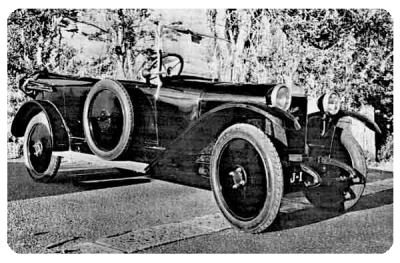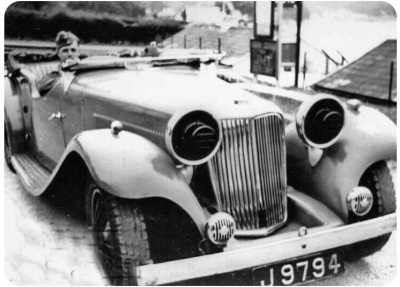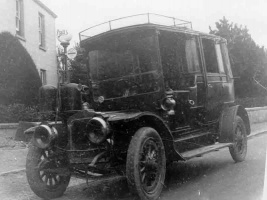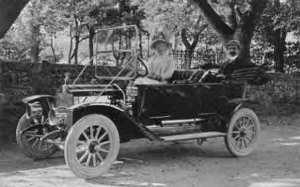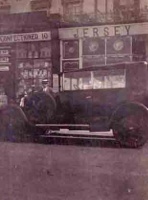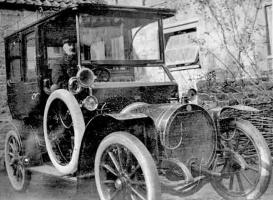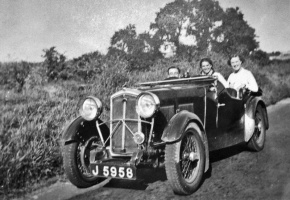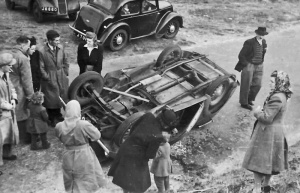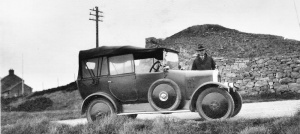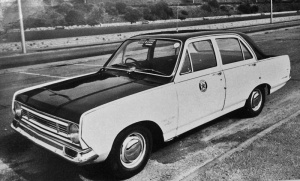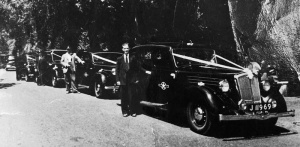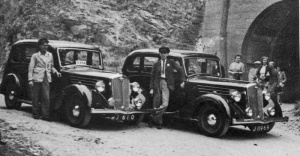Astonished townsfolk
George Balleine's History of Jersey reported the speed of what he called a '3½-horsepower Benz' as 5 mph, but noted that townsfolk were astonished at its appearance when Peter Falla drove from St John to St Helier for the first time.
The vehicle could accommodate a driver and three passengers. The driver and one passenger faced forwards and the other two faced backwards.
The arrival of the motor car in Jersey was not a cause for celebration, and Mr Falla's vehicle was dubbed La Machine du Diable (the devil's machine) and suffered the indignity of being stoned as it passed along the rough roads near Mont Mado.
Mr Falla had to import his own petrol, and send a servant to the docks to unload and collect it. He was definitely a fair weather motorist, because the car only ventured out when it was dry, and never on a Sunday, Mr Falla preferring his tricycle for the journey to church.
J0
The car was finally broken up, and it is a Benz built under licence by Grandins, of the Esplanade, which can claim to be the oldest Jersey car still in existence.
It left the island for many years, and on its return it was allocated the special registration number J0
Mr Falla maintained his interest in cars well into old age and owned an American Studebaker in 1915, when he was in his seventies.
Letter
This letter by John Boothman, president of Jersey Old Motor Club, was published in the Jersey Evening Post and gives more information on the first and second cars in Jersey.
- "I Was interested in the Temps Passé photograph of a car built in Jersey by George Pool in 1900 or 1901. It looks a fine machine. However, the description of it as ‘the first Jersey car’ is not correct. That honour goes to the 3.5 hp Benz imported to the Island by solicitor Peter Falla in July 1899.
- "This novel machine was not well received by the population of Mr Falla’s home parish of St John, and on one occasion it was stoned while climbing Mont Mado. Mr Falla did not use the car in bad weather, or on Sunday, when he went to church on his tricycle.
- "In the same year two young engineers from Grandin’s in St Helier, who had probably worked on Mr Falla’s Benz, set out to build what was a close copy of it, having first converted the key dimensions from metric to imperial. This car became known as the Jersey Benz and there is a fine period photograph of it with its creators sitting proudly aboard.
- "Sadly Mr Falla’s car has long since disappeared – only the carriage lamps remain – but the Jersey Benz is intact, having spent many years in the lobby of a west country hotel before returning to Jersey in the 1970s. It now forms part of a private local collection.
- "Comparing Mr Pool’s creation with the Benz, it looks significantly more advanced, despite being only a year or two younger. Perhaps it is no coincidence that he went on to establish one of the most successful motor businesses in Jersey."
Speed restriction
In 1923 speed restrictions were adopted by the States. The new law stated that char-a-bancs, omnibuses and motor lorries were not to travel at more than 6 mph when in town. Outside the town the maximum speed allowed was 10 mph. The Constable of St Helier said, when questioned, that the restrictions did not apply to motor cycles as, when they went too fast, they usually came into contact with objects heavier than themselves and came off second best. Jurat Le Boutillier said that even three miles per hour might be ‘dangerous’ and went on to say that the proposal was absolutely absurd. However, his fellow members disagreed and the proposition was adopted.
Registration numbers
Cars in Jersey did not initially have registration numbers. These were not introduced until around 1918, after the Great War. We are still trying to establish what procedures were followed to allocate numbers at this time but it appears that all cars registered then were allocated numbers according to the time they had been present in Jersey, starting with the oldest, the De Dion Bouton, which was given J1. There is sometimes confusion over very early vehicles bearing 'J' registrations, because this was originally the letter allocated to vehicles registered in Durham.
We would appreciate hearing (editorial@jerripedia.org) from any enthusiast who can provide further information about the process of allocating early registration numbers in Jersey.
German Occupation
This 2.5 litre Standard Swallow (Jaguar) is pictured parked in the bus stop opposite St Brelade's Bay Hotel, in the summer of 1940. The driver is a member of the Luftwaffe Reconnisance Squadron based at Jersey Airport. The car was registered in 1937.
In October 1940 in Jersey, all cars were required to be cleaned and overhauled for inspection by a German Purchasing Commission. The Order stated that 'the owner is obliged to sell his motor vehicle at the price fixed' and many people were notified that payment would be made after the War.
Emotions ran high, and on 21 November all cars – 1936 models and upwards - were ordered to be presented for purchase. A similar Order was issued the next day for the handing in of all motorcycles. The campaign to rob the Islanders of their transport, and thereby restrict their ability to move around the Islands was now well underway, and it was estimated that eventually almost 12,000 motor vehicles were seized, mostly to be sold abroad.
Pre-war Peugeot

Click on any picture to see a larger version

A photograph by Albert Smith of a family with their car
An early picture by Albert Smith of cars in a country lane

A Victoria College boy at the wheel of his father's car, photographed by Percival Dunham
A family outing, photographed by Percival Dunham
Notes and references
- ↑ Update: Further information from a Peugeot enthusiast and owner suggests that the length of the bonnet identifies this car as a Peugeot 202, first manufactured in 1939, but not previously known to have been imported to Jersey before the Occupation
- ↑ The Peugeot enthusiast who contacted us in 2023 advised that the Germans imported a number of Peugeot 302 and 402 saloons and utilities during the Occupation, some of which survived through to be restored in the 1980s
